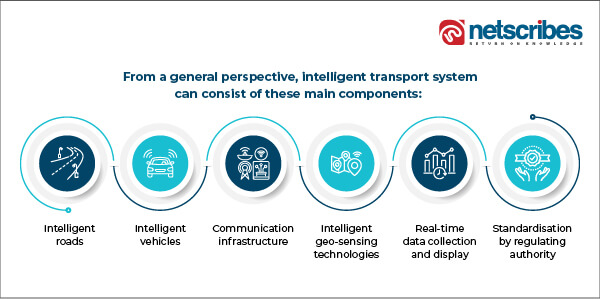HIGHLIGHTS
- Reshaping urban landscapes, intelligent transport systems are fostering greener, safer, and smarter cities by effectively managing traffic and transportation with cutting-edge technology.
- Enhancing safety, efficiency, and sustainability, these systems go beyond smart roads to optimize connectivity in railways and various other vital transport sectors.
- Additionally, they play a pivotal role in reducing carbon emissions, optimizing capacity, and enhancing road safety through route management and predictive maintenance.
An intelligent transportation system is a combination of advanced applications that aims to provide innovative services relating to different modes of transport and traffic management. It helps users to be better informed and make transportation safer, coordinated, and smarter. Intelligent transportation systems can revolutionize the way people commute with various entities of smart cities. Intelligent transportation system offers a novel approach to providing connected transportation, advanced infrastructure, and traffic and mobility management solutions. It uses many electronics, wireless, and communication technologies to provide consumers access to a smarter, safer, and faster way to the transportation industry.
Need for an intelligent transportation system
Transportation authorities continue to raise the bar for safe and hassle-free transportation for commuters. However, urban congestion, inadequate road infrastructure, aging infrastructure, road safety, and inefficient public transport are restricting the adoption of advanced technologies. Intelligent transportation systems can play a key role in solving these problems and in better managing and controlling transportation in real-time.
Intelligent transportation system is integrated with user-friendly technologies such as advanced tracking system, real-time video analytics, e-calls, AI-driven traffic control, etc. to enable efficient transport system for smart cities. Intelligent transportation systems can
- Use resources and infrastructure effectively (existing and new)
- Plan, design, and implement comprehensive transportation systems
- Provide diverse transportation options
- Control and manage urban traffic
- Make transportation safe and efficient targetable, manageable, and sustainable
How intelligent transportation systems work

Important technologies in intelligent transportation systems
- Advanced tracking system: Integration of GPS, in-vehicle communication system, and advanced driver assistance systems (ADAS) systems provide two-way communication and help traffic professionals locate vehicles, check for speeding, and provide emergency services. Traffic management centers can quickly gain visibility and alerts on hot spots or city-wide issues impacting the city’s road congestion, public safety, and emergency response systems to act and communicate more effectively with other agencies and responders.
- Vehicle-to-everything (V2X) communication: Vehicle-to-vehicle, vehicle-to-infrastructure, vehicle-to-pedestrian, vehicle-to-cloud communication are making connected environments for smart city transportation. V2X helps in traffic safety (traffic jam/accident reporting, collision warning, and collision avoidance), cooperative automated driving (traffic information exchange), entertainment services, and many other use cases in the context of intelligent transport systems.
- Advanced sensing technologies: This includes intelligent vehicle and road infrastructure sensors. Radiofrequency identification (RFI) and intelligent beacon detection technology keep drivers safe in cities worldwide. Road reflectors and induction loops are built into the road, especially useful for traffic control and safe driving at night. It can also identify slow and fast vehicles to provide information about vehicle density over time.
- Advanced video vehicle detection: Video surveillance can solve many problems for traffic. Video analytics helps to monitor traffic flow and identify emergencies and road congestion. Also, it allows automatic license plate recognition for improved security.
- Advanced traffic light system: Using radio frequency identification (RFID), advanced algorithms, and traffic databases helps to eliminate the need for manual adjustments during critical traffic conditions or rush hours.
Emergency e-call vehicle service: E-Call helps drivers connect with trained staff and send important information such as time, location, vehicle direction, and vehicle ID directly to the concerned infrastructure. The e-Call service is getting adopted by many countries. For instance, an e-call facility is mandatory for all newly registered vehicles across Europe.
Components of intelligent transport system


Related reading: Fight against climate change: Smart solar as an essential solution
Industrial benefits of intelligent transportation system
Fleet managers, operators, departments of transportation, and other agencies are turning to IoT and AI technology to address today’s transportation challenges. The incorporation of intelligent transportation systems in the industrial value chain improves the safety, traffic management, and environmental performance of roadways, railways, aviation, and maritime routes, promoting environmental sustainability and economic growth.
1. Fleet management
IoT will play a key role in enabling fleet managers, logistics companies, and drivers to make informed decisions in real-time. Network connectivity through IoT-enabled devices with integrated processor functionality establishes connectivity between vehicles, the cloud, and fleet managers. For instance, edge-enabled IoT telematics solutions can collect, store, and analyze vehicle and road condition data from GPS technology. AI technology for computer vision processes those data onboard diagnostics. Providing this data to fleet owners and managers helps them oversee vehicle maintenance, operations management, and load management. In addition, collected data can be uploaded to the cloud for global search and analysis, including trend identification and forecasting. This level of information transparency can be used to improve operations, manageability, and sustainability.
- Benefits of IoT-enabled fleet management systems
- Improved safety
- Cost savings and efficiency
- Expanded connectivity
- Increased sustainability
2. Smart roads
IoT enables cities and transport authorities to collect and analyze data to improve day-to-day traffic management. Smart road infrastructure also helps cities adapt to long-term sustainable transport needs. Using IoT sensors, cameras, radar, and 5G-enabled technology, data can be analyzed in near real-time and used to improve congested roads and optimize traffic flow. For example, traffic lights that automatically adjust their timing based on sensor data can improve traffic flow or be modified to protect other road users. The benefits of smart loading and smart infrastructure help in reducing congestion, improving traffic and pedestrian safety, and enhancing connectivity along transport infrastructure. Improving parking facilities and e-tolls, improving services and emergency response, improving road layout and sidewalk conditions, and sustainable transportation can also be achieved by incorporating an intelligent transportation system.
3. Smart railways
Railways were integral to the Industrial Revolution and played a key role in industrial raw materials and goods transportation. To meet environmental and intralogistics challenges and position themselves for future success, many governments and railway operators have incorporated smart technologies to modernize railways.
Benefits of connected railways
- Turn data into actionable insights
- Maximize the value of existing systems
- Position themselves for future success
- Increased efficiency
- Reduced downtime
- Enhanced safety
- Increased passenger satisfaction
- Predictive maintenance
- Asset tracking
- Passenger flow
4. Smart maritime and ports
Many marine transport providers today rely on disaggregated data platforms and independent point solutions. Many large IT companies like Intel, IBM, and Microsoft are working with an ecosystem of partners to support new models of intelligent and connected marine transportation. From the edge to the cloud, Intel helps transportation providers turn data into insights for fast, efficient, and informed consumption of transportation systems.
5. Smart cargo
Using intelligent transportation air transporters can have real-time tracking of cargo, predictive maintenance, and route management. Integration of AI helps in personalization, optimizing, and upscaling the interaction and digital transactions between airlines and consumers. Companies like DHL is using advanced transportation management system that helps enhance efficiency, flexibility, and cost benefits within the entire value chain.
The transportation sector is one of the major contributors to carbon emissions. Integration of intelligent transport systems helps in the reduction of carbon emissions by helping transportation companies in route management and predictive maintenance. Also, capacity optimization and reduction in road accidents can be achieved using intelligent transportation systems. Intelligent transport system provides expertise in the planning, design, implementation, and operation of solutions that focus on maximizing system performance.
Netscribes is the trusted digital partner of many leading brands, who rely on our expertise in analytics to find and collaborate with suitable solutions and develop a deeper understanding of their consumers/products. Netscribes has been a strategic partner to top organizations across sectors, helping uncover gaps in their sales funnel, and recommending a data-driven lead generation roadmap. To know how we can help your business leverage the power of deep research and information insights into your futuristic initiatives, contact us.
Based on insights by Husen Limdiwala, Manager, Market Research, and Ketaki Paygude, Senior Research Analyst.






